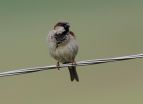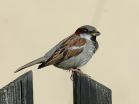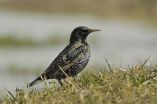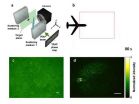The study, published today in the journal Ecology Letters, reveals a decrease of 421 million individual birds over 30 years. Around 90 percent of these losses were from the 36 most common and widespread species, including house sparrows, skylarks, grey partridges and starlings, highlighting the need for greater efforts to halt the continent-wide declines of our most familiar countryside birds.
Richard Inger from the University of Exeter said: "It is very worrying that the most common species of bird are declining rapidly because it is this group of birds that people benefit from the most."
"It is becoming increasingly clear that interaction with the natural world and wildlife is central to human wellbeing and significant loss of common birds could be quite detrimental to human society."
Birds provide multiple benefits to society. They help to control agricultural pests, are important dispersers of seeds, and scavenging species play a key role in the removal of carcasses from the environment. In addition, for many people birds are the primary way in which they interact with wildlife, through listening to bird song, enjoying the sight of birds in their local environment, feeding garden birds and through the hobby of bird watching.
The majority of the declines can be attributed to considerable losses from relatively few common birds, but not all common species are declining. Numbers of great tits, robins, blue tits and blackbirds were all shown to be increasing. Populations of rarer species, including marsh harriers, ravens, buzzards and stone curlews have also shown increases in recent years: this is likely to be the result of direct conservation action and legal protection in Europe.
Head of Species Monitoring and Research at the RSPB's Centre for Conservation Science Richard Gregory said: "The rarer birds in this study, whose populations are increasing, have benefited from protection across Europe. For example, white storks and marsh harriers receive among the highest level of protection in the EU - this is why their numbers have increased. The conservation and legal protection of all birds and their habitats in tandem are essential to reverse declines.
"This is a warning from birds throughout Europe. It is clear that the way we are managing the environment is unsustainable for many of our most familiar species."
Petr Vorisek from the PECBMS said: "The study brings a very important message to conservation practice in Europe. This would not have been possible without thousands of skilled volunteer fieldworkers who count birds according to high scientific standards and contribute their data to the national monitoring schemes."
Conservation efforts tend to be focused on rarer species but the research suggests that conservationists should also address issues affecting common birds, for example those traditionally associated with farmland. The decline in bird populations can be linked to modern farming methods, deterioration of the quality of the environment and habitat fragmentation, although the relative importance of these pressures remains unclear.
The study brought together data on 144 species of European bird from many thousands of individual surveys in 25 different countries, highlighting the value of the different national monitoring schemes increasingly working together. The researchers suggest that greater conservation funding and effort should be directed to wider scale environmental improvement programmes. These could include urban green space projects, and effective agri-environment schemes, which, informed by lessons learned from past schemes, should aim to deliver real outcomes for declining bird species whether they are rare or common.
INFORMATION:
The research is published in Ecology Letters: http://doi.wiley.com/10.1111/ele.12387
About the University of Exeter
The University of Exeter is a Russell Group university and in the top one percent of institutions globally. It combines world-class research with very high levels of student satisfaction. Exeter has over 19,000 students and is ranked 7th in The Times and The Sunday Times Good University Guide league table, 10th in The Complete University Guide and 12th in the Guardian University Guide 2014. In the 2008 Research Assessment Exercise (RAE) 90% of the University's research was rated as being at internationally recognised levels and 16 of its 31 subjects are ranked in the top 10, with 27 subjects ranked in the top 20. Exeter was The Sunday Times University of the Year 2012-13.
The University has four campuses. The Streatham and St Luke's campuses are in Exeter and there are two campuses in Cornwall, Penryn and Truro. The 2014-2015 academic year marks the 10-year anniversary of the two Cornwall campuses. In a pioneering arrangement in the UK, the Penryn Campus is owned and jointly managed with Falmouth University. At the campus, University of Exeter students can study programmes in the following areas: Animal Behaviour, Conservation Biology and Ecology, English, Environmental Science, Evolutionary Biology, Geography, Geology, History, Human Sciences, Mining and Minerals Engineering, Politics and International Relations, Renewable Energy and Zoology.
The University has invested strategically to deliver more than £350 million worth of new facilities across its campuses in the past few years; including landmark new student services centres - the Forum in Exeter and The Exchange at Penryn – together with world-class new facilities for Biosciences, the Business School and the Environment and Sustainability Institute. There are plans for another £330 million of investment between now and 2016.
http://www.exeter.ac.uk/cornwall
About the University of Exeter's Environment and Sustainability Institute (ESI)
The Environment and Sustainability Institute is a £30M interdisciplinary centre, based on the Penryn Campus, undertaking cutting-edge research into solutions to problems of environmental change; in so doing it is enhancing people's lives by improving their relationships with the environment. The ESI has three research themes: clean technologies, natural environment, and social science and sustainability. It is engaging with hundreds of businesses in Cornwall, the Isles of Scilly and beyond to translate its research and expertise across these themes into innovative business practice, products and services.
The ESI building has been designed to achieve a BREEAM 'Outstanding' status, the highest classification available under the BRE Environmental Assessment Method which is the leading and most widely used environmental assessment method for buildings.
The ESI was formally opened in April 2013 and has been funded by the European Regional Development Fund Convergence Programme (£22.9M) and the South West Regional Development Agency (£6.6M), with significant support from the Higher Education Funding Council for England.
The University of Exeter and Falmouth University are founding partners in the Combined Universities in Cornwall (CUC), a unique collaboration between six universities and colleges to promote regional economic regeneration through Higher Education, funded mainly by the European Union (Objective One and Convergence), the South West Regional Development Agency and the Higher Education Funding Council for England, with support from Cornwall Council.
http://www.exeter.ac.uk/esi
About the RSPB
The RSPB is the UK's largest nature conservation charity, inspiring everyone to give nature a home. Together with our partners, we protect threatened birds and wildlife so our towns, coast and countryside will teem with life once again. We play a leading role in BirdLife International, a worldwide partnership of nature conservation organisations.
http://www.rspb.org.uk





